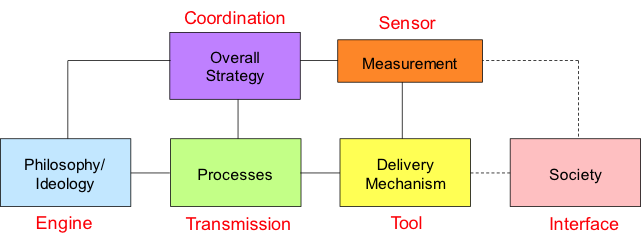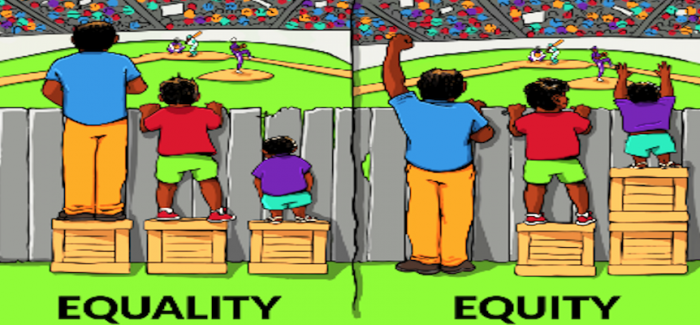Equity (Or Not)
Editor | On 08, Apr 2018
Darrell Mann
We’ve been doing quite a lot of work in the public sector this year. Which means enduring lots of noble-but-woolly thinking about concepts like equity. It usually doesn’t take long for the above image to be brought into the discussion. And then we get into the typical conservative-versus-liberal debate about ‘fair’ness. Both parties, sadly, seem equally stuck in their either/or world. And then – inevitably – matters descend into stalemate.
My first problem, I think, is with the baseball game metaphor. Sometimes we can use simple illustrations to explain more complex ideas. That is fine if the illustration is in fact used to explain the more complex idea. Often that’s not what happens – often we’re just shown the illustration, and because it’s simple, we think we understand the more complex situation automatically.
On the left, the ‘equality’ metaphor, each person has a box, but still the short guy can’t see. So, on the right, the tall guy gives him his box and all is well. That’s justice, see? Simple.
Well, if I were at a game watching over the fence and some guy needed my box to stand on, and I didn’t need it myself, of course I would give mine to him – I’m not a completely pleasant person, but I don’t think my empathy-deficit is that bad. But of course, a baseball game is not what’s really the issue here. We’re talking about wealth, poverty, and social politics – much more complex issues.
How can we translate the simple illustration to the real complex problem?
We ask what each item in the illustration represents.
What do the boxes represent? Money? Power? Knowledge? All three? Something else? Why are there only three boxes? They can’t get more? Why do they all start off with one box each? Why is one guy taller than the other? Do these guys always stay the same height over the course of their lives? How is time illustrated in this picture, if at all?
What does the fence represent? Why is it the height it is? Is it shorter in other places where the short guy could see over with only one box? Why are all three guys standing right next to each other? Can the short one sit on the tall person’s shoulders? In the real world, does the tall guy even know the short guy exists? Could the tall guy simply pass his box over to the short guy without someone else getting involved? What if the tall guy doesn’t want to give up his box? What if he’s going to need it to look over a taller section of fence further down? What does the stadium owner think about matters? If these three haven’t paid to be in the stadium, should they be allowed to watch the game at all if they haven’t paid?
What does the baseball game represent? Happiness? A house, car, and a flatscreen TV? Or just basic living needs? Who determines what poverty is? What’s being compared to what? Is the standard of living the same for all three guys? Is it essential to watch the game at all?
These are just starter questions. As they’re answered more questions will come. As soon as we try answering any of the questions, we see that the real situation is much more complex than what the picture suggests.
‘Complex’ being the key word here. The level of equality (or inequality), the level of equity (or non-equity) we might observe in our travels are emergent properties of a complex system called ‘society’.
Unless there exists a specific system within society to deliver a desired level of equality or equity, then the levels we actually achieve will only ever be emergent. i.e. unless there is an ‘equity system’ and/or an ‘equality system’, we will never have any ability to exert any control over what result emerges.
And herein, I think, lies the heart of my frustration with these kinds of noble-yet-woolly discussions. As soon as we talk about ‘systems’ – whether we’re in a complex environment or not – we’re obliged to abide by the rules of the Law Of System Completeness. Which tells us that there are six essential elements that need to be present if we are to achieve the outcomes we seek:
 Ask anyone in the public sector to help you to show you where any of these six elements are present as pertains to equality or equity issues, and the discussion quickly fizzles into a depressing haze. None of the elements exist. They don’t exist at any level, across, up or down society. And until such times as they do exist, any and all discussions about how equitable or unequal society is are pointless, hand-wringing, self-flagellating charades.
Ask anyone in the public sector to help you to show you where any of these six elements are present as pertains to equality or equity issues, and the discussion quickly fizzles into a depressing haze. None of the elements exist. They don’t exist at any level, across, up or down society. And until such times as they do exist, any and all discussions about how equitable or unequal society is are pointless, hand-wringing, self-flagellating charades.
Meanwhile, we are often heard to say, here in Systematic Innovation Land, that all contradictions can be solved. Equity-versus-equality is a contradiction. Something like this:
 But, when we make these kinds of rash ‘anything is possible’ statement, we’re making an implicit assumption: that there is a system we can utilise to enact the solution. In the case of fuzzy concepts like ‘fairness’, a simple System Completeness check reveals that there are no such systems in place. Which then forces us to have to revise our naïve heuristic:
But, when we make these kinds of rash ‘anything is possible’ statement, we’re making an implicit assumption: that there is a system we can utilise to enact the solution. In the case of fuzzy concepts like ‘fairness’, a simple System Completeness check reveals that there are no such systems in place. Which then forces us to have to revise our naïve heuristic:
‘Any contradiction can be solved provided we satisfy the Law Of System Completeness.’
By way of a simple illustration, we can very easily ‘solve’ the equity-or-equality contradiction using Inventive Principles 5 and 17: get everyone to cooperate and, when necessary, allow others to ride on their shoulders. We can design a solution, but we won’t actually deliver it until such times as we introduce an Engine, Transmission, Tool, Interface, Coordination and Sensor to make sure the right things happen at the right time and for the right reasons.

